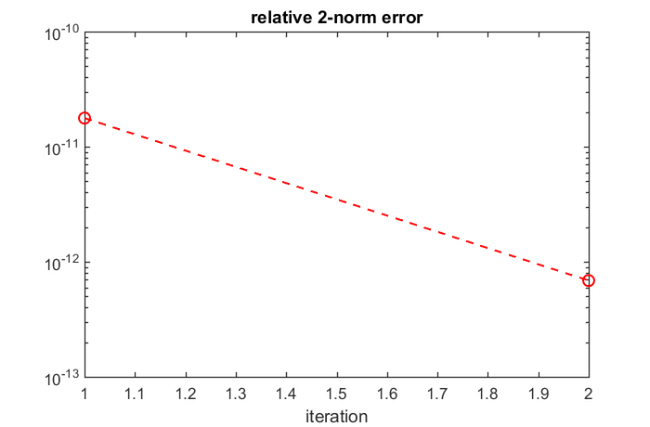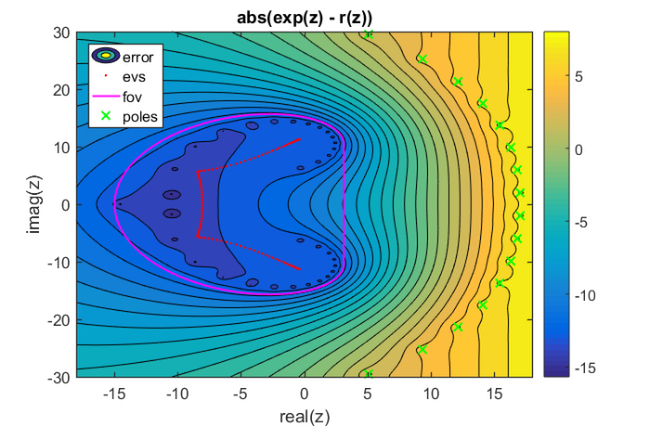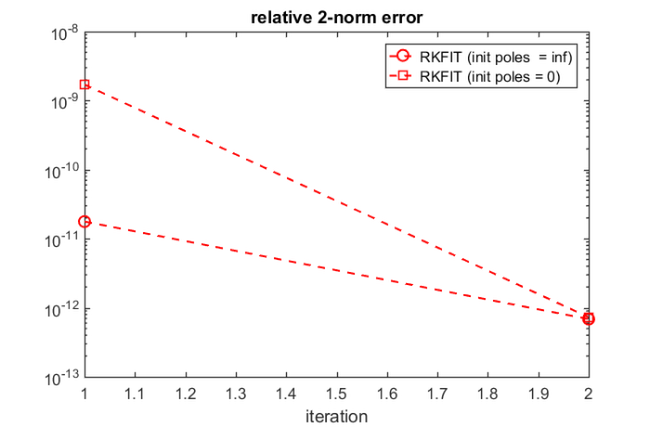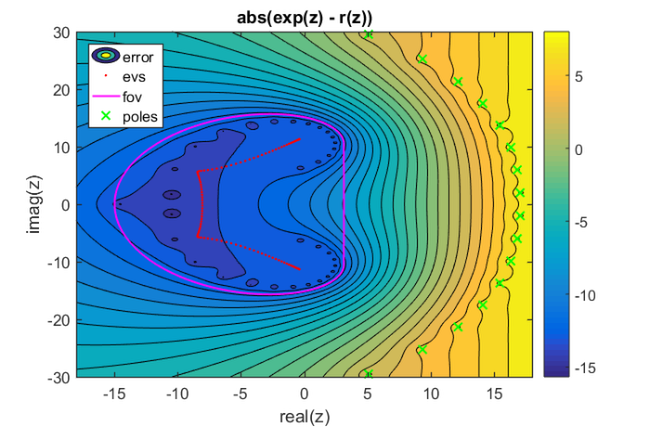Exponential of a nonnormal matrix
Mario Berljafa and Stefan Güttel, February 2015Download PDF or m-file
Contents
Introduction
This is an example of RKFIT being used for approximating  , the action of the matrix exponential onto a vector
, the action of the matrix exponential onto a vector  . RKFIT is described in [1,2] and this code reproduces Example 3 in [1].
. RKFIT is described in [1,2] and this code reproduces Example 3 in [1].
This example demonstrates that RKFIT can sometimes find sensible approximants even when  is a nonnormal and all initial poles are chosen at infinity. However, we also demonstrate that the convergence can be sensitive to the intial guess, as is not surprising with nonlinear iterations. We show how real (or complex conjugate) poles can be enforced in RKFIT.
is a nonnormal and all initial poles are chosen at infinity. However, we also demonstrate that the convergence can be sensitive to the intial guess, as is not surprising with nonlinear iterations. We show how real (or complex conjugate) poles can be enforced in RKFIT.
We first define the matrix  , the vector
, the vector  , and the matrix
, and the matrix  corresponding to
corresponding to  . Our aim is then to find a rational function
. Our aim is then to find a rational function  of type
of type  such that
such that  is small.
is small.
N = 100;
A = -5*gallery('grcar', N, 3);
b = ones(N, 1);
f = @(x) exp(x); fm = @(X) expm(full(X));
F = fm(A);
exact = F*b;
[fov, evs] = util_fovals(full(A), 100);
In order to run RKFIT we only need to specify the initial poles  of
of  . In this first test let's choose all 16 initial poles equal to infinity.
. In this first test let's choose all 16 initial poles equal to infinity.
m = 16; init_xi = inf(1, m);
Running RKFIT with real data
As all quantities  ,
,  , and
, and  , as well as the initial poles are real or infinite, it is recommended to use the 'real' option. RKFIT will then attempt to produce a rational approximant with perfectly complex conjugate (or even real) poles. We set the tolerance for the relative misfit to
, as well as the initial poles are real or infinite, it is recommended to use the 'real' option. RKFIT will then attempt to produce a rational approximant with perfectly complex conjugate (or even real) poles. We set the tolerance for the relative misfit to  :
:
maxit = 10;
tol = 1e-12;
xi = init_xi;
[xi,ratfun,misfit,out] = rkfit(F,A,b,xi,maxit,tol,'real');
xi_rkfit = xi;
All computed poles appear in perfectly complex conjugate pairs.
xi_rkfit
xi_rkfit = Columns 1 through 2 5.0886e+00 - 2.9517e+01i 5.0886e+00 + 2.9517e+01i Columns 3 through 4 9.3538e+00 - 2.5243e+01i 9.3538e+00 + 2.5243e+01i Columns 5 through 6 1.2161e+01 - 2.1323e+01i 1.2161e+01 + 2.1323e+01i Columns 7 through 8 1.4113e+01 - 1.7513e+01i 1.4113e+01 + 1.7513e+01i Columns 9 through 10 1.5456e+01 - 1.3717e+01i 1.5456e+01 + 1.3717e+01i Columns 11 through 12 1.6329e+01 - 9.8811e+00i 1.6329e+01 + 9.8811e+00i Columns 13 through 14 1.6836e+01 - 5.9754e+00i 1.6836e+01 + 5.9754e+00i Columns 15 through 16 1.7062e+01 - 2.0015e+00i 1.7062e+01 + 2.0015e+00i
Here is a convergence history of RKFIT, showing the relative misfit defined as  at each iteration. It turns out that only two iterations were required.
at each iteration. It turns out that only two iterations were required.
figure(2) semilogy(misfit, 'ro--') xlabel('iteration') title('relative 2-norm error')

Evaluating the rational approximant
The second output ratfun is an object that can be used to evaluate the computed rational approximant. This evaluation is implemented in two ways. The first option is to evaluate a matrix function  by calling ratfun(A,b) with two input arguments. For example, here we are calculating the absolute misfit:
by calling ratfun(A,b) with two input arguments. For example, here we are calculating the absolute misfit:
disp(norm(F*b - ratfun(A,b)))
3.7847e-12
Alternatively, we can evaluate  pointwise by giving only one input argument. Let's plot the modulus of the scalar error function
pointwise by giving only one input argument. Let's plot the modulus of the scalar error function  over a region in the complex plane:
over a region in the complex plane:
[X,Y] = meshgrid(linspace(-18,18,500),linspace(-30,30,500)); Z = X + 1i*Y; E = f(Z) - ratfun(Z); figure(1) contourf(X,Y,log10(abs(E)),linspace(-16,8,25)) hold on plot(evs,'r.', 'MarkerSize', 6) plot(fov, 'm-') plot(xi_rkfit, 'gx') xlabel('real(z)'); ylabel('imag(z)') title('abs(exp(z) - r(z))') legend('error', 'evs', 'fov', 'poles', ... 'Location', 'NorthWest') colorbar

Some other choices for the initial poles
Choosing all initial poles equal to infinite seems to work fine. Let us try a finite initial guess, e.g., choosing all poles at  :
:
init_xi = zeros(1, m);
Again, RKFIT requires only  iterations:
iterations:
[xi,ratfun,misfit,out] = rkfit(F,A,b,init_xi,maxit,tol,'real'); figure(2), hold on semilogy(misfit,'rs--') legend('RKFIT (init poles = inf)','RKFIT (init poles = 0)')

Finally, let's change the initial poles to  . This turns out to be an unlucky initial guess and RKFIT fails to find a minimizer within
. This turns out to be an unlucky initial guess and RKFIT fails to find a minimizer within  iterations. Note that the matrix
iterations. Note that the matrix  is highly nonnormal and RKFIT is a nonlinear iteration, which will probably make the convergence analysis of this example very involved.
is highly nonnormal and RKFIT is a nonlinear iteration, which will probably make the convergence analysis of this example very involved.
init_xi = -10*ones(1, m); [xi,ratfun,misfit,out] = rkfit(F,A,b,init_xi,maxit,tol,'real'); semilogy(misfit,'r*--') legend('RKFIT (init poles = inf)','RKFIT (init poles = 0)',... 'RKFIT (init poles = -10)')

That's it. The following creates a thumbnail.
figure(1), plot(NaN)

References
[1] M. Berljafa and S. Güttel. Generalized rational Krylov decompositions with an application to rational approximation, SIAM J. Matrix Anal. Appl., 36(2):894--916, 2015.
[2] M. Berljafa and S. Güttel. The RKFIT algorithm for nonlinear rational approximation, SIAM J. Sci. Comput., 39(5):A2049--A2071, 2017.